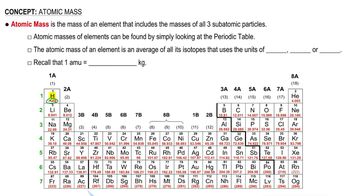How much energy must be supplied to break a single aluminum-27 nucleus into separated protons and neutrons if an aluminum-27 atom has a mass of 26.9815386 amu? How much energy is required for 100.0 g of aluminum-27? (The mass of an electron is given on the inside back cover.)
Ch.21 - Nuclear Chemistry

Brown15th EditionChemistry: The Central ScienceISBN: 9780137542970Not the one you use?Change textbook
Chapter 21, Problem 50a
The atomic masses of nitrogen-14, titanium-48, and xenon-129 are 13.999234 amu, 47.935878 amu, and 128.904779 amu, respectively. For each isotope, calculate (a) the nuclear mass.
 Verified step by step guidance
Verified step by step guidance1
1. The nuclear mass of an isotope is the mass of the protons and neutrons in the nucleus. The atomic mass unit (amu) is defined such that the mass of a carbon-12 atom is exactly 12 amu. This means that 1 amu is approximately equal to the mass of a proton or a neutron.
2. To calculate the nuclear mass of an isotope, you need to know the number of protons and neutrons in the nucleus. The atomic number of an element gives the number of protons, and the mass number (the number in the isotope's name) gives the total number of protons and neutrons. Subtract the atomic number from the mass number to find the number of neutrons.
3. For nitrogen-14, the atomic number of nitrogen is 7, so there are 7 protons and 7 neutrons. Multiply the number of protons and neutrons by 1 amu to get the nuclear mass.
4. Repeat this process for titanium-48 and xenon-129. The atomic number of titanium is 22, so there are 22 protons and 26 neutrons. The atomic number of xenon is 54, so there are 54 protons and 75 neutrons.
5. Remember that these calculations will give you an approximate nuclear mass. The actual nuclear mass may be slightly different due to the binding energy of the nucleus, which is not accounted for in this calculation.

Verified video answer for a similar problem:
This video solution was recommended by our tutors as helpful for the problem above.
Video duration:
4mWas this helpful?
Key Concepts
Here are the essential concepts you must grasp in order to answer the question correctly.
Atomic Mass Unit (amu)
The atomic mass unit (amu) is a standard unit of mass used to express atomic and molecular weights. It is defined as one twelfth of the mass of a carbon-12 atom, which is approximately 1.66 x 10^-27 kg. This unit allows chemists to compare the mass of different atoms and molecules on a relative scale, making it easier to understand their properties and behaviors in chemical reactions.
Recommended video:
Guided course

Atomic Mass
Nuclear Mass
Nuclear mass refers to the mass of an atomic nucleus, which is primarily determined by the number of protons and neutrons it contains. This mass is slightly less than the sum of the individual masses of the nucleons due to the binding energy that holds them together, as described by Einstein's equation E=mc². To calculate the nuclear mass, one must account for this mass defect, which is the difference between the total mass of the separate nucleons and the actual mass of the nucleus.
Recommended video:
Guided course

Nuclear Binding Energy
Isotopes
Isotopes are variants of a particular chemical element that have the same number of protons but different numbers of neutrons, resulting in different atomic masses. For example, nitrogen-14 has 7 protons and 7 neutrons, while nitrogen-15 has 7 protons and 8 neutrons. Understanding isotopes is crucial for calculations involving nuclear mass, as each isotope's unique neutron count affects its overall mass and stability.
Recommended video:
Guided course

Isotopes
Related Practice
Textbook Question
Textbook Question
The atomic masses of hydrogen-2 (deuterium), helium-4, and lithium-6 are 2.014102 amu, 4.002602 amu, and 6.0151228 amu, respectively. For each isotope, calculate
(c) the nuclear binding energy per nucleon.
Textbook Question
Based on the following atomic mass values: 1H, 1.00782 amu; 2H, 2.01410 amu; 3H, 3.01605 amu; 3He, 3.01603 amu; 4He, 4.00260 amu—and the mass of the neutron given in the text, calculate the energy released per mole in each of the following nuclear reactions, all of which are possibilities for a controlled fusion process:
(a) 21H + 31H → 42He + 10n
(b) 21H + 21H → 32He + 10n
(c) 21H + 32He → 42He + 11H
1
views
